Sarah Sundin's Blog, page 191
February 8, 2019
Today in World War II History—Feb. 8, 1944

Soviet artillerymen firing at German fortifications, Nikopol, Jan 1944 (Photo: mil.ru Ministry of Defense of the Russian Federation)
75 Years Ago—Feb. 8, 1944: In counterattack at Anzio, Italy, Germans retake Carroceto and secure Buonriposo Ridge.
Soviets take important manganese center of Nikopol in Ukraine.
February 7, 2019
The Sky Above Us – Tour: D-Day in the Air
 To celebrate the release of The Sky Above Us, I’m conducting a photo tour of locations from the novel that I saw on my research trip to England and Normandy.
To celebrate the release of The Sky Above Us, I’m conducting a photo tour of locations from the novel that I saw on my research trip to England and Normandy.
February 6—London!
Today—D-day in the Air
February 8—Duxford Air Museum
February 9—the Queen Mary (sister ship of the Queen Elizabeth)
Don’t forget to enter The Sky Above Us Release Day Giveaway, which includes lots of items I picked up on the trip! Giveaway runs Feb. 5-12, 2019.
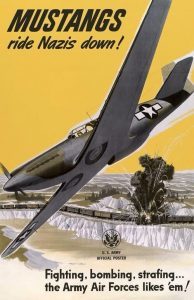
US poster featuring the North American P-51B Mustang, WWII
In The Sky Above Us, US fighter pilot Lt. Adler Paxton flies a P-51 Mustang in treacherous dogfights with the German Luftwaffe as the Allies battle for air superiority in the days leading up to D-day. Then on D-day, he flies over the landing beaches in Normandy. Today I’m featuring photos from my research trip to England and Normandy that relate to the aerial aspect of D-day.
D-day, Operation Overlord, is one of the most pivotal events of World War II and modern history. For four years, Hitler’s Nazi Germany had occupied most of Europe. During that time period, the Allies slowly regained strength and weaponry. On June 6, 1944, 156,000 British, Canadian, American, Free French, and other Allied troops invaded northern France in Normandy, supported by almost 200,000 Allied naval personnel, while 11,000 aircraft flew overhead.
Allied aerial operations on D-day were complicated, but largely successful, with notable exceptions. The transport planes dropped paratroopers. The bombers targeted German transportation, communications, and strongpoints. And the fighters covered the invasion area, strafed ground targets, and kept the Luftwaffe away from Allied troops.

Map of the Allied air plan for the landings in Normandy, 6 June 1944. (From Saunders, Hilary St. George. Royal Air Force 1939-1945, Volume III: The Fight Is Won. London: Her Majesty’s Stationery Office, 1954. Public domain via Hyperwar website).
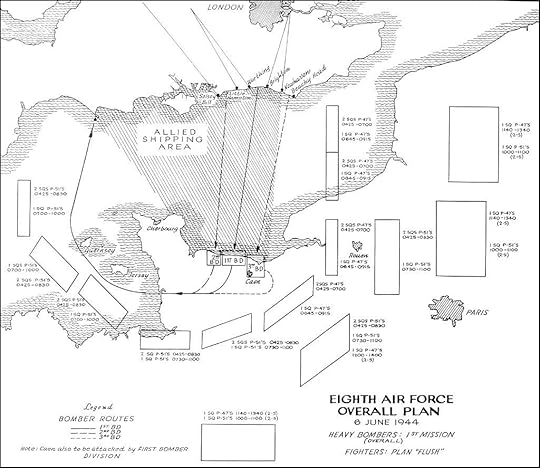
Map of the US Eighth Air Force plan for 6 June 1944 (From Sunday Punch in Normandy: The Tactical Use of Heavy Bombardment in the Normandy Invasion. Washington, DC: Center for Air Force History, 1992 (new imprint). Public domain via Hyperwar website)

Map of Allied aerial operations from March-August 1944, Normandy American Cemetery and Memorial, Colleville-sur-Mer, France, September 2017 (Photo: Sarah Sundin)
The first planes aloft were transport aircraft and gliders carrying the paratroopers of the British 6th Airborne Division and the US 82nd and 101st Airborne Divisions. Over 1400 US C-47s, C-53s, and gliders, and 364 RAF Dakotas, Albemarles, and gliders participated. The paratroopers secured crucial bridges and gun batteries and towns and generally confused the Germans before the landings. The landings in the British sector went extraordinarily well, but low clouds and heavy antiaircraft fire caused chaos in the American landings. Despite being scattered and mixed, the paratroopers showed incredible ingenuity and courage and fought where they landed.

US C-47 Skytrain and representations of Gen. Dwight Eisenhower and US paratroopers at the Airborne Museum, Sainte-Mère-Église, France, September 2017 (Photo: Sarah Sundin)
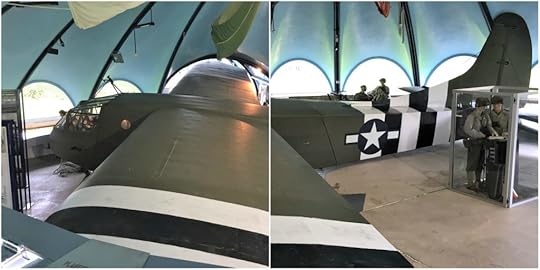
Waco glider (2 photos superimposed) at the Airborne Museum, Sainte-Mère-Église, France, September 2017 (Photo: Sarah Sundin)

Church of Sainte-Mère-Église, France, where US paratroopers landed on D-day. (Photo: September 2017, Sarah Sundin)
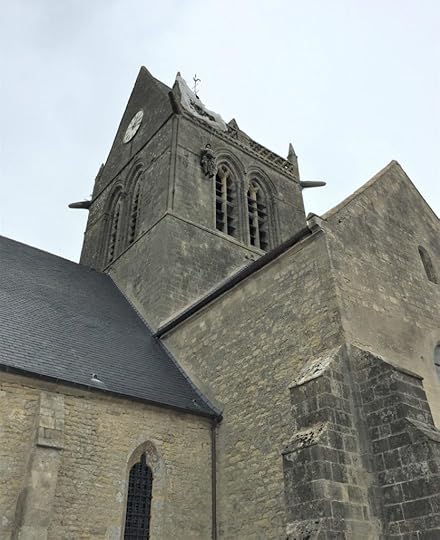
Close-up of church of Sainte-Mère-Église, France, showing memorial to paratrooper John Steele of the US 505th PIR, whose parachute caught on the steeple. He was taken prisoner by the Germans, but later escaped to fight again. (Photo: September 2017, Sarah Sundin)

Memorial window for US paratroopers in church of Sainte-Mère-Église, France. (Photo: September 2017, David Sundin)
On the night of June 5-6, 1136 heavy bombers of the British Royal Air Force hit ten Nazi gun batteries on the coast of France. Later analysis showed the reinforced concrete gun casemates were not destroyed; however, damage to supplies and rattling of the crews did impede German activity during the landings.
During the day, the bombers of RAF Coastal Command guarded the English Channel to prevent German submarines and surface craft from reaching the fleet.
At first light on D-day, the B-17 Flying Fortresses and B-24 Liberators of the US Eighth Air Force targeted German strongpoints behind the beaches as well as the beaches themselves. Due to low clouds, they had to use blind radar bombing. To avoid short bombing, in which they might have hit the landing craft speeding toward shore, they delayed bomb release. As a result, German defenses on the beaches, particularly at Omaha, were undamaged, and the GIs didn’t have the craters they’d been promised for hiding. However, the bombs falling farther inland probably hindered German reinforcement.

B-17 Flying Fortress “Sally B” (also painted as the “Memphis Belle” on one side), Imperial War Museum, Duxford, England, September 2017 (Photo: Sarah Sundin)
The medium bombers of the US Ninth Air Force did phenomenal work on Utah Beach. In an incredibly dangerous low-level run, 293 B-26 Marauders blasted the beach, damaging fortifications and leaving plenty of protective craters.
More medium and light bombers and fighter-bombers of the US Ninth Air Force and the RAF 2nd Tactical Air Force hit vital German road, rail, and bridge targets, making communication and reinforcement impossible.
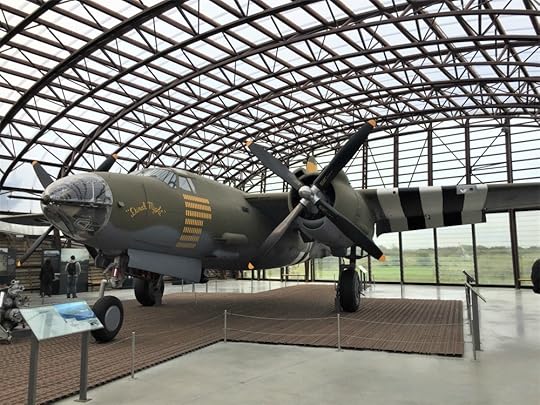
B-26 Marauder “Dinah Might,” Utah Beach D-Day Museum, Sainte Marie du Mont, France, September 2017 (Photo: Sarah Sundin)
Over 4000 fighters of the US Eighth and Ninth Air Forces, plus thousands of RAF fighters flew on that day. US P-38 Lightnings were chosen to cover the shipping lanes. Their unique twin-boomed silhouette was easily recognizable and less likely to be shot down by trigger-happy Allied sailors and soldiers. RAF Spitfires flew cover high above the landing beaches, and US P-47 Thunderbolts and P-51 Mustangs, both of which had longer range than the Spitfire, maintained a defensive perimeter in a broad semicircle around the invasion area. Later in the morning and throughout the day, US and RAF fighters strafed German road, rail, and bridge targets.

RAF Spitfire, Imperial War Musuem, Duxford, England, September 2017 (Photo: Sarah Sundin)

US P-51 Mustang, Imperial War Museum, Duxford, England, September 2017 (Photo: Sarah Sundin)
What didn’t happen on D-day is particularly notable. The German Air Force was essentially absent. This was due to months of the Allied pre-invasion campaign, which sought to destroy the Luftwaffe in the air, on the ground, and in the factory—and to bomb German airfields in the weeks prior to the landings. Indeed, the Luftwaffe only managed to fly 319 sorties in the entire Normandy region that day, with only a single strafing run over the landing beaches by two particularly brave Focke-Wulf Fw 190s. We can only imagine what might have happened if the Allies had not obtained air superiority.
Please join me tomorrow when we’ll tour the Imperial War Museum’s air museum at Duxford, England.
Today in World War II History—Feb. 7, 1944
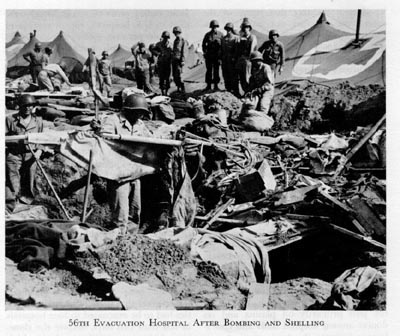
US 56th Evacuation Hospital after a similar air raid, 1944 (US Army Medical Department)
75 Years Ago—Feb. 7, 1944: US secures Kwajalein Atoll in the Marshall Islands.
At Anzio, Italy, US 95th Evacuation Hospital is accidentally bombed when a German fighter pilot jettisons bombs under Allied fighter attack; 28 hospital personnel and patients are killed, including 3 nurses and the first female American Red Cross worker to be killed in action in WWII; the German pilot is shot down and treated in the same hospital.
John Hersey’s best-selling novel A Bell for Adano is published; it will win the Pulitzer Prize.
February 6, 2019
The Sky Above Us – Tour of London
 To celebrate the release of The Sky Above Us, I’m conducting a photo tour of locations from the novel that I saw on my research trip to England and Normandy.
To celebrate the release of The Sky Above Us, I’m conducting a photo tour of locations from the novel that I saw on my research trip to England and Normandy.
Today—London!
February 7—D-day in the Air
February 8—Duxford Air Museum
February 9—the Queen Mary (sister ship of the Queen Elizabeth)
Don’t forget to enter The Sky Above Us Release Day Giveaway, which includes items I picked up on the trip! Giveaway runs Feb. 5-12, 2019.
London! A beautiful city brimming with millennia of history. When my heroine, Violet Lindstrom, arrives in England in December 1943, she and her fellow American Red Cross workers see the sights! As a small-town girl, Violet is a bit overwhelmed by the big city, but she enjoys seeing Westminster Abbey, Houses of Parliament, and Big Ben before they report to American Red Cross Headquarters at Grosvenor Square. To see photos of these famous London sights—as well as Grosvenor Square—please see my photo tour from The Sea Before Us.
Violet and her friends also see Buckingham Palace and famous Harrod’s Department Store!

Buckingham Palace, September 2017 (Photo: Sarah Sundin)

Gate at Buckingham Palace, September 2017 (Photo: Sarah Sundin)

Harrod’s, London, September 2017 (Photo: Sarah Sundin)
US fighter pilot Lt. Adler Paxton visits London on Easter Sunday 1944. There he worships at Westminster Abbey and sees the same sights Violet saw, as well as Horse Guards, St. James’s Park, and the Tower Bridge.

Horse Guards, London, September 2017 (Photo: Sarah Sundin)
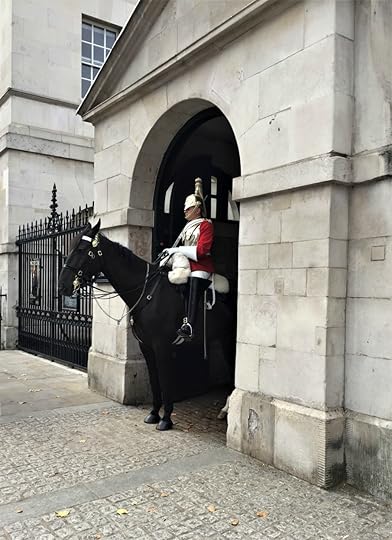
Mounted trooper of the Household Cavalry, Horse Guards, London, September 2017 (Photo: Sarah Sundin)

Sarah Sundin and her children in St. James’s Park, London, July 2009 (Photo: David Sundin)

Tower Bridge, London, July 2009 (Photo: David Sundin)
Adler and his buddies from his fighter squadron enjoy a stroll through Hyde Park that Easter Sunday. However, Adler isn’t prepared to see a face from his past…

Hyde Park, London, September 2017 (Photo: Sarah Sundin)

Bandstand in Hyde Park, London, September 2017 (Photo: Sarah Sundin)

Bandstand in Hyde Park, London, September 2017 (Photo: Sarah Sundin)

Birds on the Serpentine in Hyde Park, London, September 2017 (Photo: Sarah Sundin)

Where paths intersect in Hyde Park…where lives intersect in The Sky Above Us (Photo: London, September 2017, Sarah Sundin)
Hope to see you tomorrow for “D-Day in the Air.” We’ll see sights pertaining to the aerial aspect of D-day.
Today in World War II History—Feb. 6, 1944

P-47 Thunderbolt piloted by Capt. Raymond Walsh of the US 406th Fighter Group is silhouetted against the exploding ammunition truck he just strafed, France, 23 Jun 1944 (US National Archives)
75 Years Ago—Feb. 6, 1944: Soviets make major breakthrough in Ukraine and reach the Dnieper River near Nikopol.
US Eighth Air Force sends out its first fighter aircraft ground strafing mission.
February 5, 2019
The Sky Above Us Release Day Giveaway!

To celebrate the release of The Sky Above Us, I’m giving away a prize pack of items I picked up in England and Normandy on my research trip! Come join me on Facebook Live Video on February 5, 2019 at 10 am PST/1 pm EST where I’ll describe the items and their significance to the story! The video will be available for viewing afterward as well.
Please join me here on my blog throughout this week for a photo tour from my research trip to England and Normandy!
To help you get “In the Mood” for the story, I’m giving away a package including:
Mini die-cast model of a P-51B Mustang!
Sand I collected from Omaha Beach, in a commemorative jar
Aviation-themed postcards from the Imperial War Museum
Tote bag from Imperial War Museum, Duxford
London souvenir tea towel
WWII poster playing cards
Commemorative D-day pen
“Yanks replica pack” from the Imperial War Museum, with replicas of Red Cross leaflets, “A Short Guide to Great Britain,” General Eisenhower’s D-day address, Yank Magazine, and even jitterbug instructions!
The Sky Above Us key chain



The giveaway is open February 5-12, 2019. US mailing addresses only please. The winner will be announced here on my blog on February 13, 2019 and will be notified by email.
Enter below with the Rafflecopter form below.
Today in World War II History—Feb. 5, 1944

Submarine USS U-3008 (former German sub U-3008) with snorkel raised. (US Navy photo)
75 Years Ago—Feb. 5, 1944: Germans deploy the first U-boat with a “Schnorchel” to increase time a submarine could stay submerged.
Colossus Computer at Bletchley Park in England is first used to decode German messages.
New songs in Top Ten: “Besame Mucho” and “Mairzy Doats.”
Movie premiere of first of 15-part Captain America serial, the first theatrical release featuring a Marvel character, starring Dick Purcell & Lorna Gray.
February 4, 2019
Today in World War II History—Feb. 4, 1944

US Marine signalmen setting up a command post in the streets of Roi-Namur, Kwajalein, Marshall Islands, 1 Feb 1944 (US National Archives)
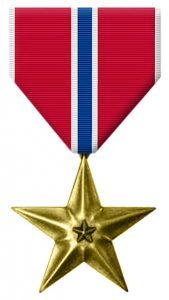
Bronze star (US Army Institute of Heraldry)
75 Years Ago—Feb. 4, 1944: US secures Kwajalein and Majuro Islands in Kwajalein Atoll.
Japanese open offensive against Indian troops on Arakan, Burma.
US authorizes Bronze Star medal for meritorious or heroic achievement, less than the Silver Star, retroactive to 7 Dec 1941.
US Navy blimp K-29 makes the first carrier landing by a nonrigid airship, on escort carrier USS Altamaha off San Diego, CA.

K-29 of Airship Patrol Squadron ZP-31 lifts off from escort carrier USS Altamaha off the California coast, 24 Feb 1944 (US Navy photo)
February 3, 2019
Today in World War II History—Feb. 3, 1944
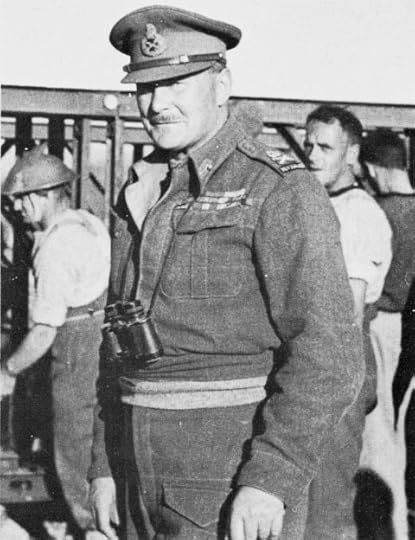
Lt. Gen. Sir Bernard Freyberg, WWII (US Army Center of Military History)
75 Years Ago—Feb. 3, 1944: In Italy, New Zealand Corps is formed under Lt. Gen. Sir Bernard Freyberg over New Zealand 2nd Division and Indian 4th Division.
Italian Fascists violate Vatican City sovereignty and arrest several Jews hiding there.
February 2, 2019
Today in World War II History—Feb. 2, 1944

Remains of Italian barracks near Cassino, Italy, February 1944 (US Army Center of Military History)
75 Years Ago—Feb. 2, 1944: Soviets enter German-occupied Estonia.
In Italy, US II Corps enters outskirts of Cassino town and takes Italian barracks area at Montevilla.



